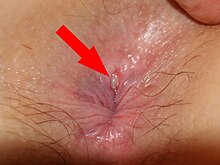Anal fissure
| Classification according to ICD-10 | |
|---|---|
| K60.0 | Acute anal fissure |
| K60.1 | Chronic anal fissure |
| ICD-10 online (WHO version 2019) | |
An anal fissure (fissura ani) is a painful tear in the skin or mucous membrane of the anus in many cases . It stereotypically affects the posterior commissure of the anal canal (“6 o'clock lithotomy position ”) and is radial (radial).
causes
The general cause is the tearing of the anoderm when passing hard stool (for example in the case of chronic constipation ) and in the case of forced defecation .
Furthermore, tears in inflammatory conditions (anodermal eczema ) can occur due to a loss of elasticity of the anal skin. The underlying cause is often a neighboring cryptoglandular inflammation, which is essentially based on liquid stool or increased anal mucus discharge, which is mostly based on chronic inflammatory bowel disease . As a result, the anoderm can also become inflamed and lose its elasticity, so that an increasingly consistent stool can lead to a tear (fissure).
In addition, sexual practices such as inserting objects, fisting or anal intercourse can cause an anal fissure. Even with the birth of a child, the skin of the anal region can rip through the strong expansion.
Symptoms
Light, sharp pain during and persistent burning after bowel movements are typical. The pain leads to a reflex spasm of the sphincter muscle , which often means that the stool can only be forced and delivered in a thin (pencil-strong) strand. Occasionally, there will be light, bright red bleeding. Fear of the next bowel movement can contribute to constipation, which makes the disease worse (→ dyschezia ).
diagnosis
The diagnosis is usually made from the patient's indications and an inspection of the anus. The fissure is typically visible at 6 o'clock in the lithotomy position (towards the tailbone), less often at 12 o'clock (towards the perineum). On palpation , a palpable, painful ulcer or a rough, painful cord and the sphincter spasm point the way . Occasionally, swollen anal papillae can also be felt at the transition from the mucous membrane to the skin, which in severe cases can lead to anal prolapse .
In the differential diagnosis, hemorrhoids should always be excluded, which is often possible based on the position of the end arteries at 3, 7 and 11 a.m.
therapy
The therapy of the fresh (acute) anal fissure begins with stool regulation. If there is severe pain or burning sensation after a bowel movement, it may be necessary to apply an ointment with the addition of a local anesthetic . Achieving a permanently soft and shaped stool consistency is crucial. A fresh anal fissure usually heals within six to eight weeks.
Good anal hygiene is a prerequisite for the fissure to heal and for pain relief. The anus area is cleaned with lukewarm water with the help of pH-neutral soaps and a well-moistened washcloth.
With a chronic fissure , the symptoms have persisted for more than two months. In addition to stool regulation, conservative treatment options are the local application of ointments to improve blood circulation and relax the anal sphincter. Active ingredients that are regularly used for this purpose are nitroglycerin or calcium channel blockers such as diltiazem and nifedipine . Alternatives are botulinum toxin injection or surgical sanitation. In the long term, conservative ointment treatment can achieve healing in every second patient, and in around 90% of all cases with surgical repair.
The classic surgical procedure consists of cutting out ( excising ) the fissure including the scarred tissue while taking along the proportionate crypts and the enlarged anal papillae or the so-called outpost fold (Mariske) . Since no sutures are usually used in this procedure, the wound takes about four to six weeks to heal. Stretching the anal sphincter muscles under anesthesia is now considered obsolete and harmful.
Partial severing of the sphincter muscles ( sphincterotomy ) is no longer a therapeutic option today. The problem with this method is, after initially good therapeutic success, the risk of developing faecal incontinence in old age (sometimes decades after the actual operation). This is not least due to the physiologically decreasing sphincter muscle tone with age .
literature
- M. Kraemer, D. Bussen and others: Nationwide survey on the therapeutic approach to hemorrhoidal disease and anal fissure. In: surgeon. Volume 69, 1998, pp. 215-218. PMID 9551274
- A. Wittmer, A. Wittmer among others: Etiology and therapy of chronic anal fissure. In: Coloproctology . Volume 25, 2003, pp. 16-22.
- JN Lund, PO Nyström et al: Evidence-based algorithm for the treatment of anal fissures. In: Coloproctology . Volume 29, pp. 1-5.
Web links
Individual evidence
- ↑ a b chirurgie-portal.de: anal fissure, anal fissure, operation.
- ↑ Therapy of the anal fissure. from Peter Buchmann: Textbook of Proctology, 4th edition 2002, Verlag Hans Huber, Bern, 79–89.
- ↑ Long-term results when comparing glycerine trinitrate and botulinum toxin A in the treatment of chronic anal fissures. Coloproctology 28 · 2006 · No. 5, Publisher: Urban & Vogel.
